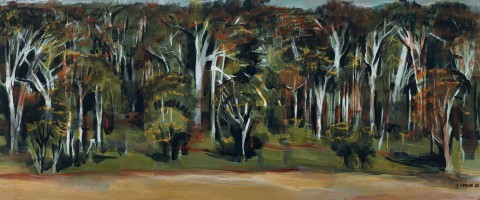KARRI FOREST, 1963
HOWARD TAYLOR
oil on composition board
49.5 x 118.5 cm
65.5 x 134.5 cm (inc. artist’s frame)
signed and dated lower right: H. TAYLOR 63
Private collection, Perth and South Australia
Thence by descent
Private collection, Western Australia
Karri Forest, 1963, oil on composition board, 49.7 x 118.5 cm, Kerry Stokes Collection, Perth, illus. in Howard Taylor: Phenomena, Art Gallery of Western Australia, Perth, 2003, p. 86
With a vast, innovative oeuvre spanning five decades, Howard Taylor is widely revered as one of the most significant artists of the late twentieth century to interpret the Australian landscape. Honoured in 2003 with a major retrospective at the Art Gallery of Western Australia and Museum of Contemporary Art, Sydney, indeed critics have subsequently proclaimed Taylor an ‘old master’ in the same vein as Sidney Nolan and Fred Williams. While firmly rooted within the landscape tradition of Australian art, his work however defies definition, standing resolutely outside any particular ‘school’ or ‘movement’. As Anthony Russell observes, ‘…his vision went far beyond the focus of any painter before him, in that none of them – irrespective of their unquestioned brilliance – ever interrogated and captured the complexity of structure, the ephemeral quality of its light and colour, or the rich and subtle patina of its living forms, as he did.’1
Based in the remote sun-drenched town of Northcliffe, near the karri forests of Albany, Western Australia, Taylor devoted his talent almost exclusively to observing and immortalising the Australian bush. Employing a notebook to record in an empirical manner the barely perceptible nuances of the karri forests that dominated his environs, thus Taylor developed an acute awareness of the continuous cycles of change and renewal within Nature. Interestingly, as the artist’s appreciation of the various discrepancies within the landscape deepened, so too did his discovery of the art of the early Europeans and specifically, the egg tempera technique which he perceived integral in his untiring struggle to capture the transient effects of light and colour.2
Executed during the early 1960s – a period witnessing Taylor’s most active engagement in public commissions – Karri Forest, 1963 attests superbly to the artist’s enduring preoccupation with this single unifying motif. Yet unlike his paintings of the previous decade which betray Taylor’s predilection for the metaphysical art of British surrealist Paul Nash, the present reveals more immediately its landscape sources – a painterly effect heightened by his return to the oil technique. Describing the important transitional nature of these works, thus Taylor reflects, ‘I came to a stage, painting in tempera, where I began to think that I had been using an outmoded technique… I did in the end, feel that I ought to oil paint, and at that period of course there was a lot of interest in more gestural painting, more expressive painting. I think for a while I succumbed to that weakness, but then I was able to steer my oil painting to a more organised approach, sort of akin to the tempera painting but working in a freer way…’3
Simple in composition, yet irresistibly complex in its tension between figure and ground, literal and abstract, material and conceptual, the work articulates powerful ideas concerning perception, the mechanics of vision, and the relationship of the image to site, viewer and artist. Thus, the work Karri Forest, 1963 encapsulates well the artist’s lifelong quest for an essential unity and order in the apparent unruliness of Nature; as Taylor mused, ‘I’ve been obsessed for a long time by the notion of opposites in nature… I feel a great need to try and understand and explain, to tie the ends together, to get opposites to agree. I’m interested in the different ways that things can be seen and the way an artist can get a lot to happen with a refined and simple structure.’4
1. Russell, A., ‘Tribute: Howard Hamilton Taylor (1918 - 2001)’ in Towards Discovery: Paintings, Maquettes, Drawings, Galerie Dusseldorf, Perth, 2004
2. Dufour, G., ‘Visual Experience and Pictorial Structure’ in Howard Taylor: Phenomena, Art Gallery of Western Australia, Perth, 2003, p. 51
3. Taylor, H. quoted in ibid., p. 46
4. Taylor, H. in an interview with Graham, D., ‘Big timber man’, National Times, New South Wales, 19 May 1979, p. 49
VERONICA ANGELATOS
